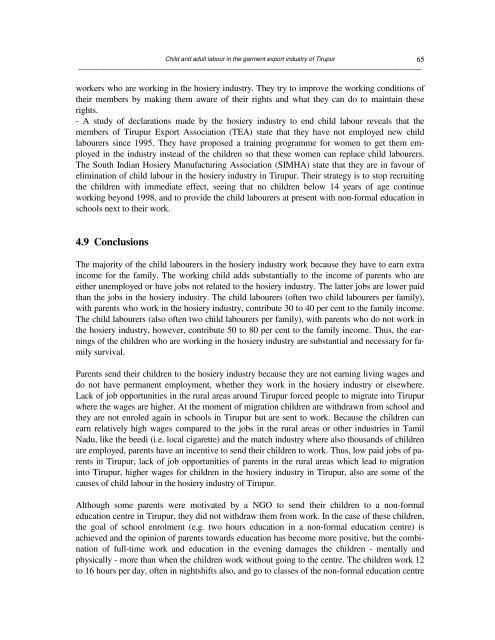You also want an ePaper? Increase the reach of your titles
YUMPU automatically turns print PDFs into web optimized ePapers that Google loves.
<strong>Child</strong> <strong>and</strong> <strong>adult</strong> <strong>labour</strong> <strong>in</strong> <strong>the</strong> <strong>garment</strong> <strong>export</strong> <strong>in</strong>dustry <strong>of</strong> Tirupur<br />
──────────────────────────────────────────────────────────────────────────────────────────────<br />
workers who are work<strong>in</strong>g <strong>in</strong> <strong>the</strong> hosiery <strong>in</strong>dustry. They try to improve <strong>the</strong> work<strong>in</strong>g conditions <strong>of</strong><br />
<strong>the</strong>ir members by mak<strong>in</strong>g <strong>the</strong>m aware <strong>of</strong> <strong>the</strong>ir rights <strong>and</strong> what <strong>the</strong>y can do to ma<strong>in</strong>ta<strong>in</strong> <strong>the</strong>se<br />
rights.<br />
- A study <strong>of</strong> declarations made by <strong>the</strong> hosiery <strong>in</strong>dustry to end child <strong>labour</strong> reveals that <strong>the</strong><br />
members <strong>of</strong> Tirupur Export Association (TEA) state that <strong>the</strong>y have not employed new child<br />
<strong>labour</strong>ers s<strong>in</strong>ce 1995. They have proposed a tra<strong>in</strong><strong>in</strong>g programme for women to get <strong>the</strong>m employed<br />
<strong>in</strong> <strong>the</strong> <strong>in</strong>dustry <strong>in</strong>stead <strong>of</strong> <strong>the</strong> children so that <strong>the</strong>se women can replace child <strong>labour</strong>ers.<br />
The South <strong>India</strong>n Hosiery Manufactur<strong>in</strong>g Association (SIMHA) state that <strong>the</strong>y are <strong>in</strong> favour <strong>of</strong><br />
elim<strong>in</strong>ation <strong>of</strong> child <strong>labour</strong> <strong>in</strong> <strong>the</strong> hosiery <strong>in</strong>dustry <strong>in</strong> Tirupur. Their strategy is to stop recruit<strong>in</strong>g<br />
<strong>the</strong> children with immediate effect, see<strong>in</strong>g that no children below 14 years <strong>of</strong> age cont<strong>in</strong>ue<br />
work<strong>in</strong>g beyond 1998, <strong>and</strong> to provide <strong>the</strong> child <strong>labour</strong>ers at present with non-formal education <strong>in</strong><br />
schools next to <strong>the</strong>ir work.<br />
65<br />
4.9 Conclusions<br />
The majority <strong>of</strong> <strong>the</strong> child <strong>labour</strong>ers <strong>in</strong> <strong>the</strong> hosiery <strong>in</strong>dustry work because <strong>the</strong>y have to earn extra<br />
<strong>in</strong>come for <strong>the</strong> family. The work<strong>in</strong>g child adds substantially to <strong>the</strong> <strong>in</strong>come <strong>of</strong> parents who are<br />
ei<strong>the</strong>r unemployed or have jobs not related to <strong>the</strong> hosiery <strong>in</strong>dustry. The latter jobs are lower paid<br />
than <strong>the</strong> jobs <strong>in</strong> <strong>the</strong> hosiery <strong>in</strong>dustry. The child <strong>labour</strong>ers (<strong>of</strong>ten two child <strong>labour</strong>ers per family),<br />
with parents who work <strong>in</strong> <strong>the</strong> hosiery <strong>in</strong>dustry, contribute 30 to 40 per cent to <strong>the</strong> family <strong>in</strong>come.<br />
The child <strong>labour</strong>ers (also <strong>of</strong>ten two child <strong>labour</strong>ers per family), with parents who do not work <strong>in</strong><br />
<strong>the</strong> hosiery <strong>in</strong>dustry, however, contribute 50 to 80 per cent to <strong>the</strong> family <strong>in</strong>come. Thus, <strong>the</strong> earn<strong>in</strong>gs<br />
<strong>of</strong> <strong>the</strong> children who are work<strong>in</strong>g <strong>in</strong> <strong>the</strong> hosiery <strong>in</strong>dustry are substantial <strong>and</strong> necessary for family<br />
survival.<br />
Parents send <strong>the</strong>ir children to <strong>the</strong> hosiery <strong>in</strong>dustry because <strong>the</strong>y are not earn<strong>in</strong>g liv<strong>in</strong>g wages <strong>and</strong><br />
do not have permanent employment, whe<strong>the</strong>r <strong>the</strong>y work <strong>in</strong> <strong>the</strong> hosiery <strong>in</strong>dustry or elsewhere.<br />
Lack <strong>of</strong> job opportunities <strong>in</strong> <strong>the</strong> rural areas around Tirupur forced people to migrate <strong>in</strong>to Tirupur<br />
where <strong>the</strong> wages are higher. At <strong>the</strong> moment <strong>of</strong> migration children are withdrawn from school <strong>and</strong><br />
<strong>the</strong>y are not enroled aga<strong>in</strong> <strong>in</strong> schools <strong>in</strong> Tirupur but are sent to work. Because <strong>the</strong> children can<br />
earn relatively high wages compared to <strong>the</strong> jobs <strong>in</strong> <strong>the</strong> rural areas or o<strong>the</strong>r <strong>in</strong>dustries <strong>in</strong> Tamil<br />
Nadu, like <strong>the</strong> beedi (i.e. local cigarette) <strong>and</strong> <strong>the</strong> match <strong>in</strong>dustry where also thous<strong>and</strong>s <strong>of</strong> children<br />
are employed, parents have an <strong>in</strong>centive to send <strong>the</strong>ir children to work. Thus, low paid jobs <strong>of</strong> parents<br />
<strong>in</strong> Tirupur, lack <strong>of</strong> job opportunities <strong>of</strong> parents <strong>in</strong> <strong>the</strong> rural areas which lead to migration<br />
<strong>in</strong>to Tirupur, higher wages for children <strong>in</strong> <strong>the</strong> hosiery <strong>in</strong>dustry <strong>in</strong> Tirupur, also are some <strong>of</strong> <strong>the</strong><br />
causes <strong>of</strong> child <strong>labour</strong> <strong>in</strong> <strong>the</strong> hosiery <strong>in</strong>dustry <strong>of</strong> Tirupur.<br />
Although some parents were motivated by a NGO to send <strong>the</strong>ir children to a non-formal<br />
education centre <strong>in</strong> Tirupur, <strong>the</strong>y did not withdraw <strong>the</strong>m from work. In <strong>the</strong> case <strong>of</strong> <strong>the</strong>se children,<br />
<strong>the</strong> goal <strong>of</strong> school enrolment (e.g. two hours education <strong>in</strong> a non-formal education centre) is<br />
achieved <strong>and</strong> <strong>the</strong> op<strong>in</strong>ion <strong>of</strong> parents towards education has become more positive, but <strong>the</strong> comb<strong>in</strong>ation<br />
<strong>of</strong> full-time work <strong>and</strong> education <strong>in</strong> <strong>the</strong> even<strong>in</strong>g damages <strong>the</strong> children - mentally <strong>and</strong><br />
physically - more than when <strong>the</strong> children work without go<strong>in</strong>g to <strong>the</strong> centre. The children work 12<br />
to 16 hours per day, <strong>of</strong>ten <strong>in</strong> nightshifts also, <strong>and</strong> go to classes <strong>of</strong> <strong>the</strong> non-formal education centre


















